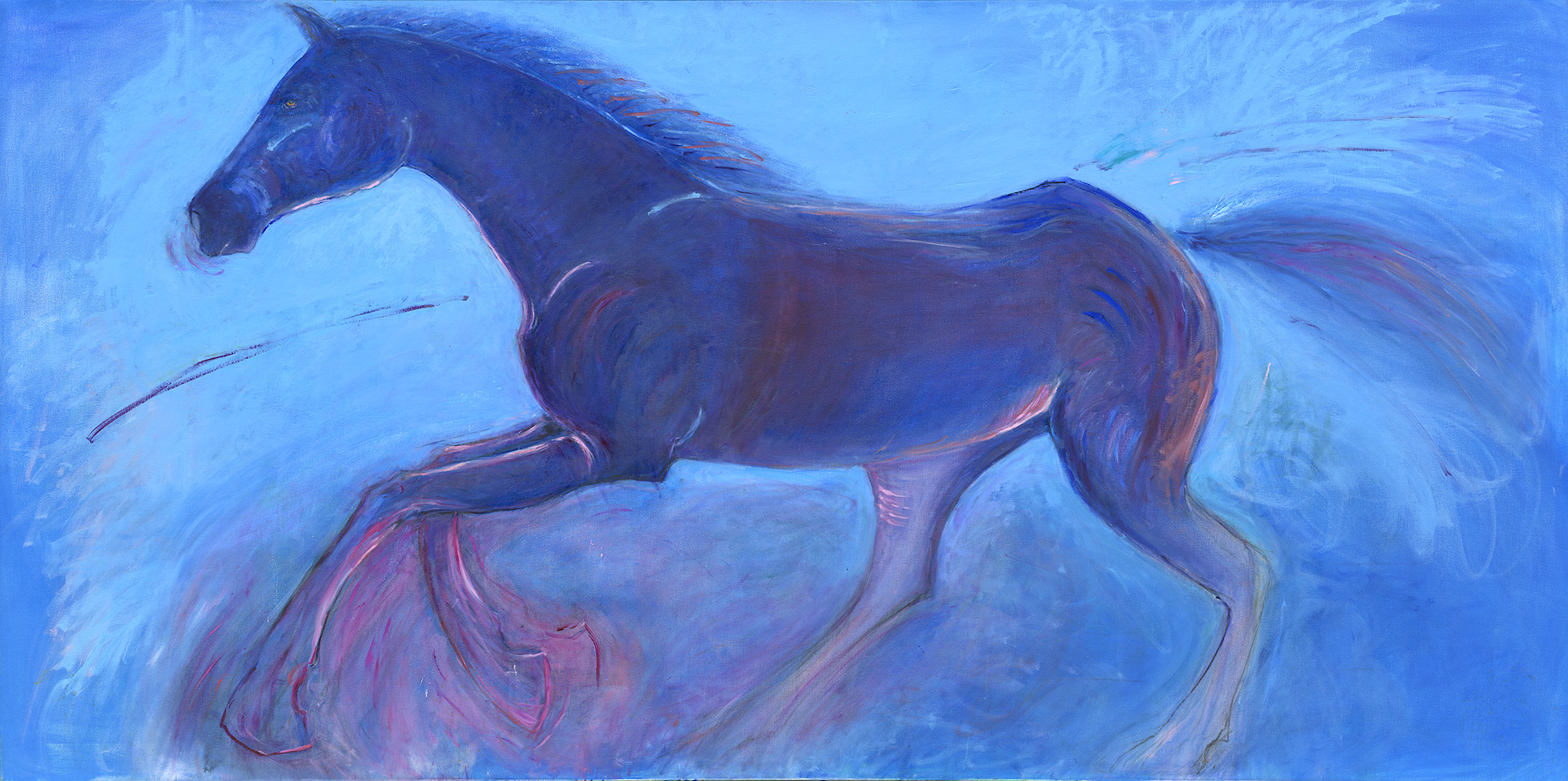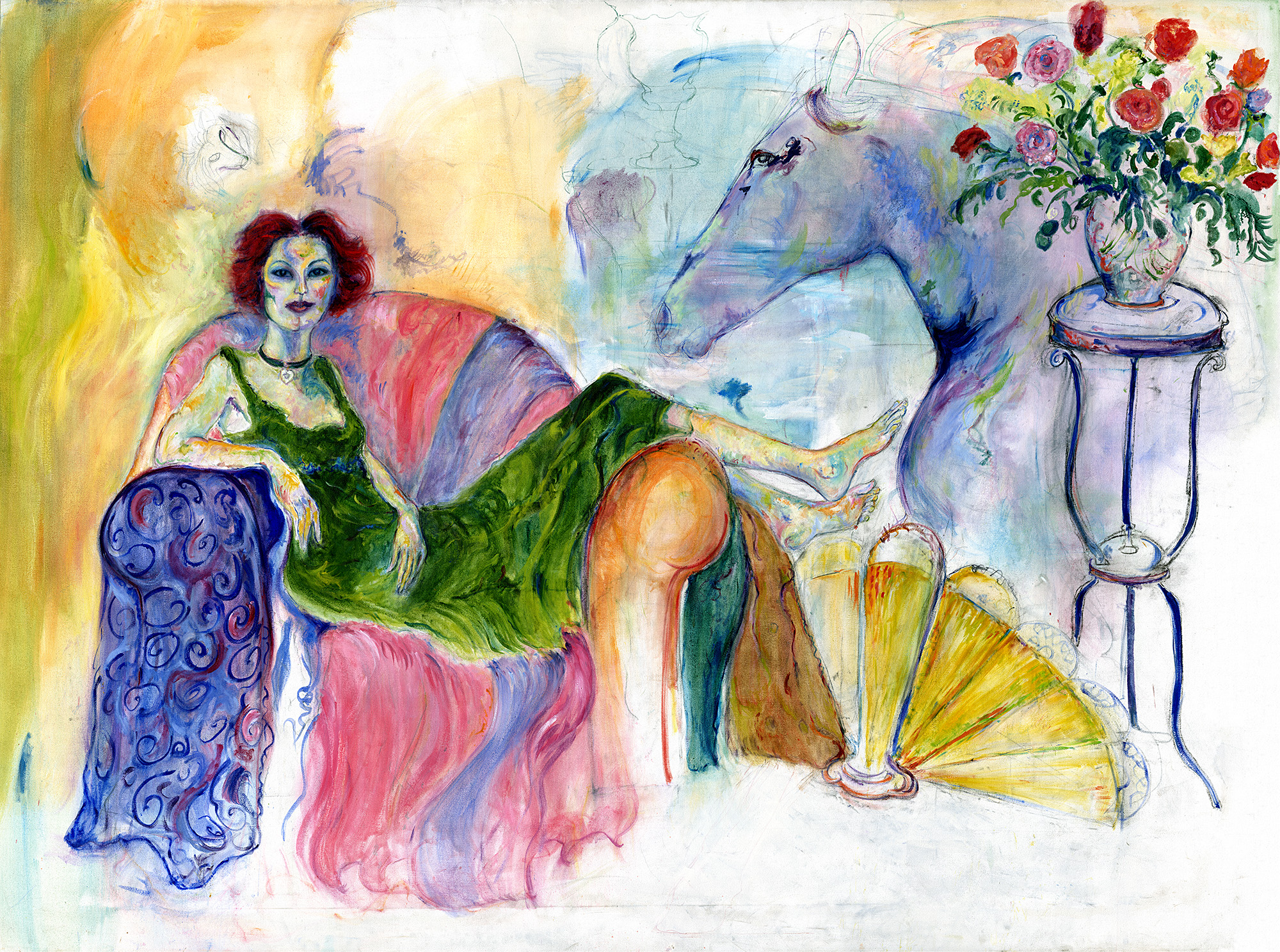A Delicate and Fleeting Atmosphere Breathes.
Beauty adopts the most varied and whimsical ways of presenting itself, sometimes ornamenting reality and drawing from it those virtues that give sustenance to the soul.
The artist Hollye Davidson, through her works, brings us close to a world at once animal and human, entangling it in a beauty that on occasion breathes in silence and at other times tends to launch shouts that besiege or cry out for help. The pieces selected for the exhibition Line and Essence arm themselves with these two presences, the images of horses living different moments of their lives and the female presence, so brief and fleeting that we feel that in a few moments, it will disappear.

Two formal factors distinguish her work: the way in which she sometimes conjugates line with color, making them mutually dependent, without our ability to discern in which moments one predominates, and a second factor related to the aesthetic qualities of elegance and delicacy, qualities that gradually form different circumstances, fleeting moments that breathe and tend toward lightness.
Hollye achieves this intimate atmosphere, filled with brief moments, through the rhythm and movement that she imprints on each figure, especially in what meaning can be gleaned from a point of arrival, which becomes an antechamber to other forms of life.
The horse, a favorite character, is usually shown looking at the viewer in an insistent manner, from an expression that judges, questions, doubts and threatens, warning us of the setbacks that subsistence can bring us. Her greatest representation is found in the piece Galliope, where an enormous blue mare, “riderless” as the critic and curator Gined López would say, gallops forward, showing off her beauty, fearing nothing. Among all the works, she is distinguished not only by the monumentality that makes her powerful, but also, by that beauty of blue situated above any human valuation. Her arrogance distinguishes her with her gallop looking ahead; she is different from the rest of her peers who observe the spectator waiting for their judgments.
Among the images of horses positioned at different moments, either detained or waiting to stalk, ready to gallop or reared up, aggressive and annoyed, there is one galloping with his head inclined to one side and one who, full of colors, is looking calmly ahead. A special circumstance is contained in the work Fleurs de Pamela, in which we see a woman seated astride a couch, and at one end, the figure of a horse observes her, tilting its head, alone in his thoughts, serving as a protective guard. The woman remains calm, nothing disturbs her. Apparently, this imagined companion must be well known to her.

Another part of the show includes a set of pieces featuring shy or arrogant female figures. They are full of stories and secluded fables, the viewer can imagine many stories, but the artist’s interest does not stay there, it goes beyond, to highlight the human content of each pose and of the imagined environments. These details are what enhance their power, everything seems to be directed toward the spiritual intensity they contain, toward their mystery, toward narratives that are only announced under light and firm lines. The figures loaded with colors impel us to feel them as pure ornaments, although this coloring makes them more expressive, the interpretations that they incite are unprejudiced and calm, they are not subject to the emotional ups and downs of the rest of the works.
While the background of some of the works remains neutral, in others it penetrates the unfolding of the images, it plays no other role than to accompany them, however, with it the artist reinforces that subtlety that characterizes her painting.
In one of the most mysterious pieces, Tenderness, the sketch of a female figure can be appreciated. It is a delicate image, drawn with only a few lines, her hand is on her chest, and she remains half-dressed while her eyes delimit her, standing out with an intensity that evokes suffering, unhappiness, susceptibility, her tenderness does not save her from her pain. In this vein, it is praiseworthy to note how the creator manages to concentrate the meaning of the piece in practically one detail, sustained concomitantly by a simple image that becomes powerful as a result.
Another significant work is Natasha Reclining, in which an attractive woman appears calmly seated in an armchair, with the intention of provoking the observer with her gaze. Once again the gaze acquires a central role, concentrating the power of the work, a power that ramifies as calm, naive, and astute.
Portrait von Jodi is the most daring work of the exhibition, because the woman represented does not seem to care about the events and changes of this world, the attraction from her voluptuousness, her elaborate hair and bold pose make her vigorous, self-confident. The colorful face contrasts with the fine lines in which the body is diluted. The gaze does not forgive a doubter, the viewer must be sure of what they want when they look at her.
On the other hand, in Return to Yellow, a work close to the previous one, the power is concentrated on a face wrapped in yellow, with an expression as disquieting and inquisitive as the above. On this occasion, the lines she draws are governed by color and this makes it stand out within the context of the works exhibited. But something important relates this piece to the others, again, the subtle power of the gaze, which in this case is different from the others, because it is full of doubts, fear, and insecurity about what may be happening.
These readings of some works seek to comment on the different intentions and interpretations that can be provoked, because although they are simple in their composition and brief in their visual solution, they are insinuating and provocative in their meanings. They are silent, insecure, making us think that the destinies that surround them could be dangerous.
The contrast between human values and visual solutions is one of the contributions that the artist has put forward with great skill. When we observe carefully, none of the figures is complacent and this contrasts with those solutions, which in most cases intrigue from their own formal conception by showing a simplicity that supports complex content.
This contrast is one of the most commendable values of the works, which together with the beauty that governs them and the quiet humanity that sustains them, summons the jumble of feelings which so closely reflect our daily life.
Magaly Espinosa Delgado.
Barcelona, Spain, October 2023
Prof. Magaly Espinosa Delgado holds a Doctorate in Philosophical Sciences, with a specialization in Aesthetics, (University of Kiev, Ukraine). Dr. Espinosa is the author of “Indagaciones. El nuevo arte cubano y su estética” (Inquiries. The New Cuban Art and its Aesthetics), a pivotal work that explores the intricacies of contemporary Cuban art. She also co-edited “Antología de textos críticos: El nuevo arte cubano” (Anthology of Critical Texts: New Cuban Art) alongside Kevin Power, a work that has played an instrumental role in shaping the discourse on Latin American art.
Espinosa Delgado, Magaly (2023). In cat. Line and Essence, Exhibition by GG Art Space, Miami, FL, United States of America.
Leave a Reply